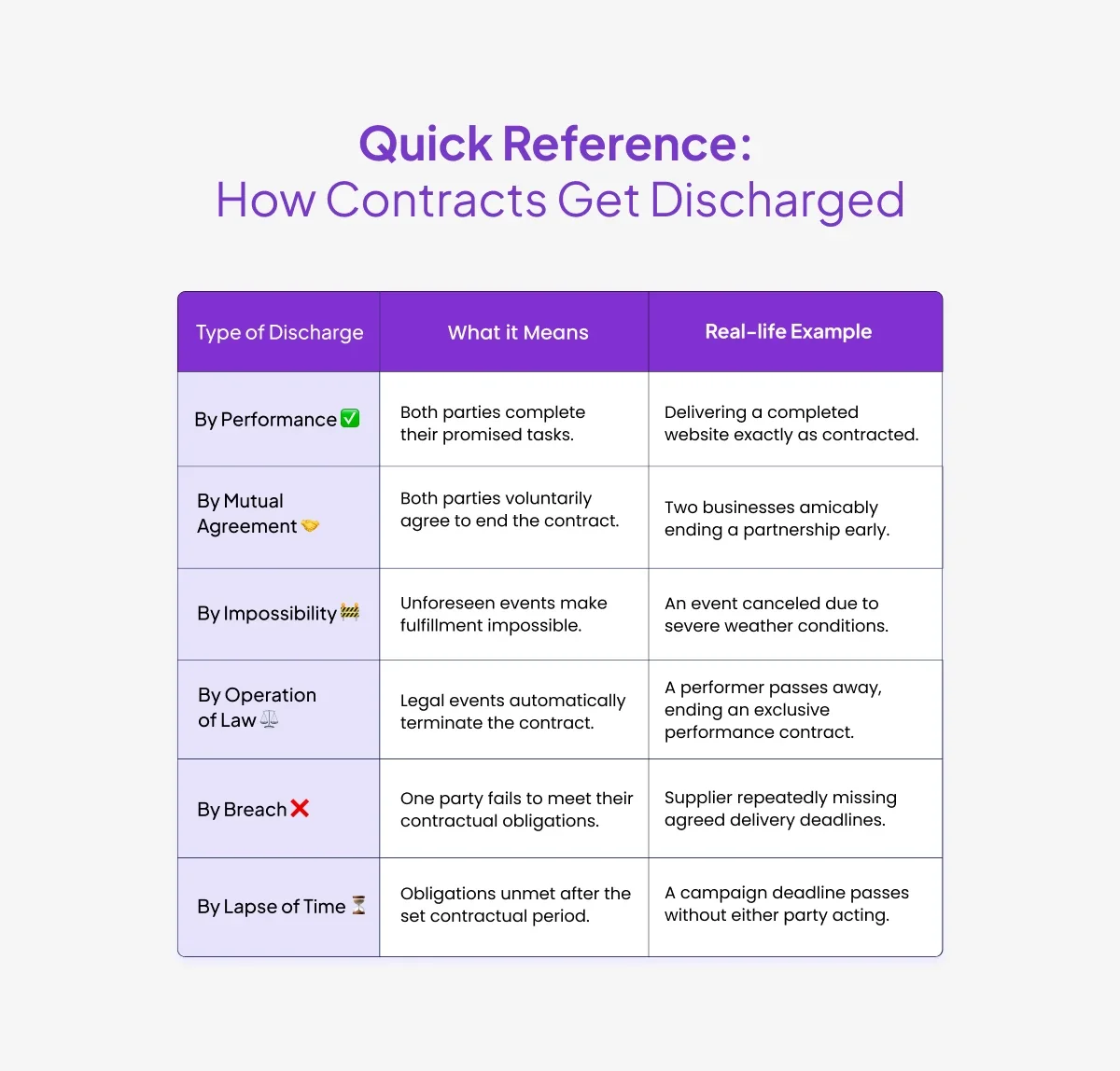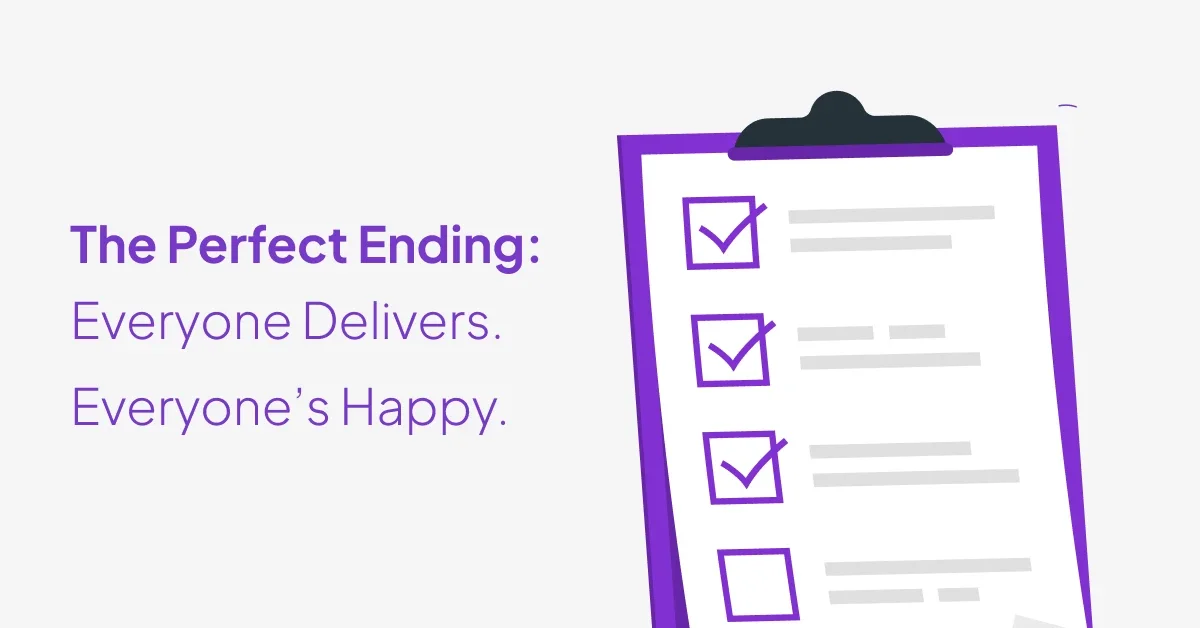Contracts can sometimes feel a bit like relationships. You meet, set clear expectations, and hope everyone holds up their end of the bargain.
But like relationships, contracts sometimes run their course, require adjustments, or simply come to an end. Understanding precisely how contracts conclude, or are "discharged", is essential knowledge, especially for businesses, entrepreneurs, freelancers, and anyone regularly dealing with agreements.
In simple terms, the discharge of a contract refers to the ending of contractual obligations. Once discharged, all parties involved no longer have duties to fulfill under the agreement. This knowledge not only protects you legally but ensures your business operations remain smooth and dispute-free.
Let's explore this concept in comprehensive detail, including the various ways a contract can be discharged, complete with practical examples.
What is Discharge of Contract?
The discharge of a contract is essentially the conclusion or ending of a contractual agreement. This happens when the obligations and responsibilities outlined in the agreement no longer apply. Imagine building a house: once all tasks—from laying the foundation to placing the last roof tile—are completed, the construction contract naturally ends, leaving no remaining duties.
Understanding the discharge of contracts thoroughly can help you avoid confusion, legal complications, and financial losses. It provides clarity, ensures all parties remain accountable, and helps manage business relationships effectively.
Read: Contract vs Agreement: Everything you Need to Know!
Types of Discharge of Contract
Contracts typically discharge through six primary methods, each significant in different scenarios:
Discharge by Performance
This is the most straightforward and desired outcome, occurring when all parties fulfill their obligations exactly as specified in the contract.
Example: Suppose you hire a professional photographer to cover an event. Once the event concludes and the photographer delivers the agreed photos, both obligations are met, and the contract is discharged.
Discharge by Mutual Agreement
Contracts can also end when both parties mutually agree to terminate or amend their obligations due to changed circumstances, business priorities, or mutual benefit.
Example: Two firms sign an agreement to collaborate on research for three years. After one year, both companies decide to pursue different strategic goals. Through mutual discussion, they agree to end the contract early, amicably discharging the agreement.
Discharge by Impossibility of Performance
Sometimes contracts become impossible to fulfill due to unforeseen circumstances. Events such as natural disasters, sudden legislative changes, or loss of necessary resources can make contractual duties impossible to complete.
Example: A shipping company is contracted to deliver goods overseas. Unexpectedly, war breaks out in the destination country, rendering safe delivery impossible. The contract would then be discharged due to the impossibility of performance.
Discharge by Operation of Law
Contracts can automatically end under certain legal conditions, including bankruptcy, mergers, death of a crucial party, or other legal shifts affecting contractual terms.
Example: A famous singer contracts to perform at an event, but tragically passes away. Because the performance relied on their unique talent, the contract is automatically discharged by operation of law.
Discharge by Breach
A breach occurs when one party fails significantly or repeatedly to fulfill contractual obligations. The non-breaching party can terminate the contract, often seeking compensation for damages incurred.
Example: Suppose an IT company contracted to maintain cybersecurity for a business repeatedly misses scheduled updates, leaving the client vulnerable. The client can legally discharge the contract due to breach and potentially claim damages.
Discharge by Lapse of Time
Contracts explicitly stating performance deadlines become automatically discharged if obligations remain unmet and no party seeks enforcement after the specified period.
Example: A writer contracts to deliver a manuscript within six months. Neither the author nor publisher takes action after the deadline passes without delivery. Consequently, the contract naturally expires by lapse of time.
Also Read: 11 Types of Business Contracts You Need To Know About!
Importance of Understanding Discharge of Contract for Business
- Reduces Risk: Clear understanding minimizes chances of disputes, legal conflicts, and contractual misunderstandings.
- Prevents Financial Losses: Prevents costly litigations and potential penalties arising from breached or improperly managed contracts.
- Strengthens Business Relationships: Ensures clarity and transparency, fostering trust between all parties involved.
- Enhances Proactivity: Allows businesses to anticipate contractual issues early, enabling proactive problem-solving before issues escalate.
- Improves Decision-Making: Empowers informed, strategic decisions when adjusting or renegotiating terms due to changing circumstances.
- Protects Reputation: Minimizes chances of disputes that could harm professional credibility, maintaining trustworthiness in the market.
- Secures Opportunities: Prevents loss of critical business opportunities due to unclear or improperly handled contractual obligations.
- Ensures Compliance: Facilitates adherence to legal requirements, reducing risks associated with non-compliance or breaches.
- Provides Peace of Mind: Delivers confidence and assurance, reducing stress related to contractual uncertainties.
How ZoopSign Can Help in Manage Contracts Effectively
Handling contracts efficiently and transparently is paramount for any successful business operation. ZoopSign is a powerful digital tool designed specifically to simplify every stage of contract management, from initiation to discharge.
ZoopSign provides robust features for drafting, reviewing, and digitally signing contracts securely using Aadhaar-based signatures or digital eSignatures. Its intuitive dashboard clearly tracks contract status, deadlines, obligations, and modifications. Real-time notifications keep everyone informed, minimizing confusion and preventing breaches.
Moreover, ZoopSign seamlessly manages modifications, mutual discharges, and document collaboration, ensuring clarity and alignment among all parties involved. By adopting ZoopSign, businesses streamline contract management, significantly reduce risks, and foster strong, transparent professional relationships.
How ZoopSign Exactly Helps
Imagine you run a consulting firm with multiple ongoing client projects, each governed by separate contracts. Using traditional methods—paper documents, physical signatures, and manual tracking—can quickly become overwhelming. Mistakes or oversights can lead to costly breaches or misunderstandings.
With ZoopSign, you digitize the entire document lifecycle, including creating, signing, managing timelines, tracking performances, and promptly discharging completed contracts. Automated alerts ensure no obligations are overlooked, and digital signatures accelerate agreement processes, keeping your business agile and compliant.
Conclusion
Contracts form the backbone of professional transactions, clearly defining rights, duties, and expectations between parties. Understanding the detailed nuances of how contracts discharge isn't just academic—it’s a practical necessity in today's dynamic business landscape.
When you thoroughly comprehend each aspect of contract discharge, you gain valuable foresight into contractual engagements, reducing potential pitfalls significantly. Tools like ZoopSign further enhance this clarity, offering comprehensive digital solutions to simplify complex contractual processes.
Ultimately, clear contractual terms, proactive management, and effective digital solutions help your business maintain strong professional relationships, mitigate risks, and remain agile amidst evolving scenarios.
Next time you're working with contracts, remember that clarity combined with efficient tools like ZoopSign can make your business operations smoother, safer, and more successful.

